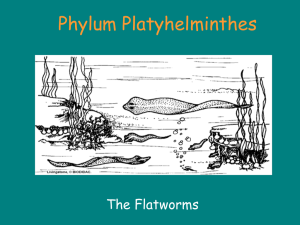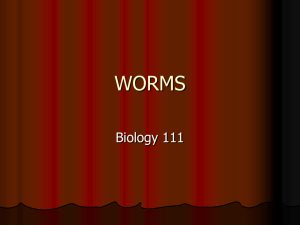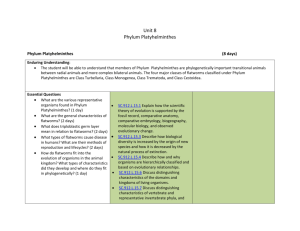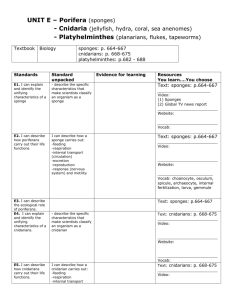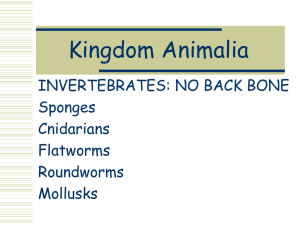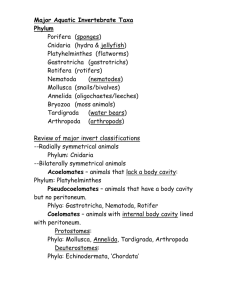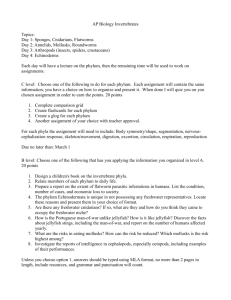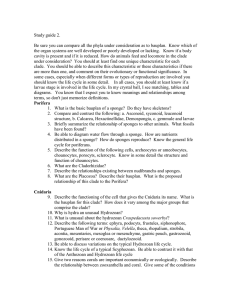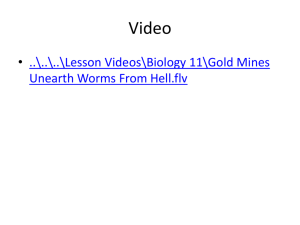Invertebrates: Phylum Porifera - hills
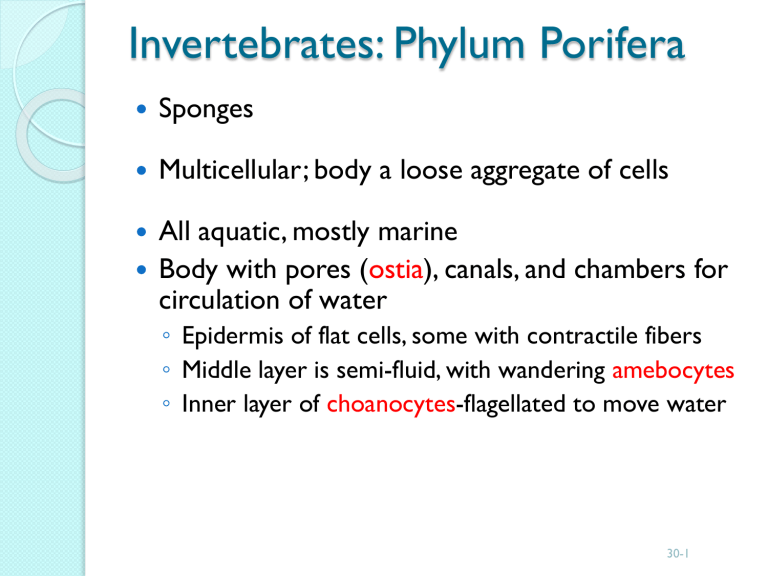
Invertebrates: Phylum Porifera
Sponges
Multicellular; body a loose aggregate of cells
All aquatic, mostly marine
Body with pores ( ostia ), canals, and chambers for circulation of water
◦ Epidermis of flat cells, some with contractile fibers
◦ Middle layer is semi-fluid, with wandering amebocytes
◦ Inner layer of choanocytes -flagellated to move water
30-1
Phylum Porifera
cont’d
Filter feeders- intracellular digestion
◦ Cells get food from circulating water
Classified based on skeleton
◦ Composed of spicules
Chalk sponges - spicules of calcium carbonate
Glass sponges - spicules of silica
Proteinaceous sponges spongin fibers
Reproduction
◦ asexual by budding, sexual by fusion of gametes
30-2
Sponge
Fig. 30.3
30-3
Invertebrates: Phylum Cnidaria
Cnidarians
◦ Multicellular, tubular or bell-shaped animalsradial symmetry
◦ All aquatic, mostly marine
2 germ layers during development
◦ Organized at tissue level
Nematocysts
◦ stinging cells unique to cnidarians
30-4
Cnidarians
cont’d
2 body typespolyps and medusae
◦ Life cycle alternates between both forms in some; in others one form is reduced or absent
Gastrovascular cavity-sac-like body plan
Includes corals, jellyfish, and hydrozoans
◦ Corals- polyps
◦ Jellyfish-medusae
◦ Hydrozoans-may have both forms
30-5
Cnidarian diversity
Fig. 30.4
30-6
Cnidarians
cont’d
Hydra
◦ Representative organism (Class Hydrozoa)
◦ Freshwater, attaches to rocks, leaf litter
◦ Small tubular polyp, sac-like body plan with a single opening
Outer tissue layer – epidermis from ectoderm
Inner layer – gastrodermis from endoderm
Longitudinal and circular muscle fibers present
Diffuse nerve net between layers
30-7
Cnidarians
cont’d
◦ Digestion begins in gastrovascular cavity, completed in cells
◦ Can reproduce sexually and asexually
(budding)
Sexual reproduction- hydra develops an ovary or testis in body wall-produces gametes
30-8
Anatomy of Hydra
Fig. 30.5
30-9
Invertebrates: Phylum Platyhelminthes
Flatworms
Bilateral symmetry, three germ layers, acoelomate
Mesoderm gives greater complexity
◦ Muscles, excretory, reproductive, and digestive systems in some
◦ Respiration by diffusion and circulation
30-10
Platyhelminthes cont’d
Class Turbellaria - Planarians
◦ Free-living flatworms
◦ freshwater, feed on small living and dead organisms
◦ Ladder-like nervous system
Ganglia and eyespots anterior
Auricles – chemosensitive receptores
◦ Digestion:
Feed through muscular pharynx
Specialized cells for excretion: flame cells
30-11
Platyhelminthes cont’d
Class Turbellaria - Planarians cont’d
◦ 3 muscle layers- circular, longitudinal, and diagonal
Allows for more complex movements
◦ Cephalization
Organized to have an anterior end and a posterior end
◦ Hermaphroditic
30-12
Planarian
Fig. 30.6
30-13
Parasitic Platyhelminthes
Class Cestoda (Tapeworms)
◦ Internal parasites as adults
◦ Body Structure
Tegument: tough outer covering
protect from host’s enzymes
Scolex - head
Barbs/hooks for attachment
Proglottids: segments
Each contains organs of both sexes
◦ Lack a digestive system- why?
30-14
Parasitic Platyhelminthes
cont’d
Class Cestoda (Tapeworms) (cont’d)
◦ Reproduction
Fertilization is internal
proglottids filled with fertilized eggs are called gravid
Gravid proglottids drop off and pass out in feces
Ingested by intermediate host
larvae become encysted
Intermediate host is then eaten by definitive host
Larvae mature to adults
◦ Representative Organism: Tanea solium
Pork tapeworm
30-15
Life cycle of a tapeworm, Taenia
Fig. 30.7
30-16
Parasitic Platyhelminthes cont’d
Class Trematoda - Flukes
◦ Endoparasites of many species
◦ Body Structure
Tegument
Oral sucker and posterior sucker
◦ Digestion
Well-developed digestive canal
30-17
Parasitic Platyhelminthes cont’d
Class Trematoda - Flukes cont’d
◦ Muscles and excretory system much like freeliving flatworms
Poorly developed sense organs- why might that be?
◦ Reproduction
Hermaphroditic
Complex life cycle involving two intermediate hosts
30-18
Parasitic Platyhelminthes cont’d
Class Trematoda - Flukes cont’d
◦ Representative Organism: Clonorchis sinensis
Liver Fluke
Transmission
Snails ingest eggs
Develop in to larvae, which leave the snail and burrow into muscles of a fish
Humans ingest fish
Larvae moves into bile ducts where adults develop
Eggs pass out of human in feces, cycle continues
30-19
Invertebrates: Phylum Nematoda
Roundworms
◦ First appearance of
Tube-within-a-tube body plan
2 openings, mouth and anus
Body Cavity
Pseudocoelomates
Pseudocoel -filled with fluid, acts as hydrostatic skeleton
◦ Many species; some are free-living in soil and water, others are parasitic
30-20
Coelom structure and function
Fig. 30.8
30-21
Parasitic Nematodes
Ascaris
◦ Move with whip-like motion
◦ Intestinal parasites in many animal species
◦ Females are much longer than males and highly prolific
◦ Eggs enter host in uncooked vegetables, soil, or feces
Larvae burrow out of intestine and migrate to heart and lungs
Larvae are coughed up and swallowed
Mature to adults in intestines
Estimated to infect 25% of world population
30-22
Roundworm anatomy
Fig. 30.9
30-23
Parasitic Nematodes cont’d
Trichinella spiralis
◦ the trichina worm
◦ Causes trichinosis
◦ Humans contract the worm by eating undercooked pork
◦ Larvae migrate out of intestines and form painful cysts in the muscles
30-24
Parasitic Nematodes cont’d
Wuchereria bancrofti
◦ filarial worm that causes elephantiasis
◦ Migrates into lymphatic vessels and prevents lymph drainage
◦ Edema occurs
30-
25
Parasitic Nematodes cont’d
Pinworms and hookworms
◦ Roundworm parasites which cause problems in children
◦ Much more common in U.S.
Pinworms are primarily an annoyance
Hookworms cause skin irritations and in some cases debilitating disease
30-26
